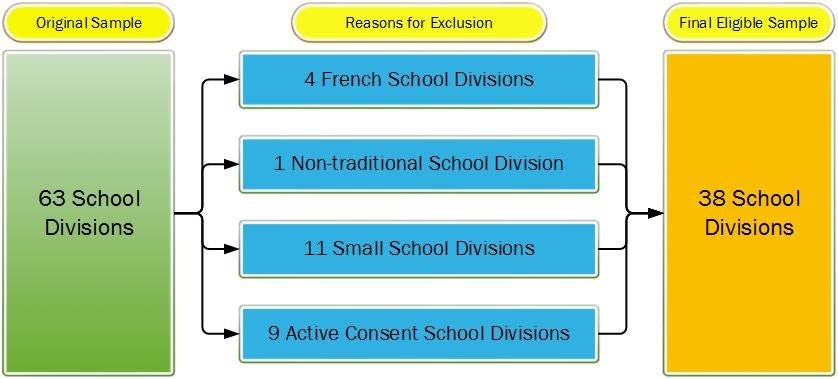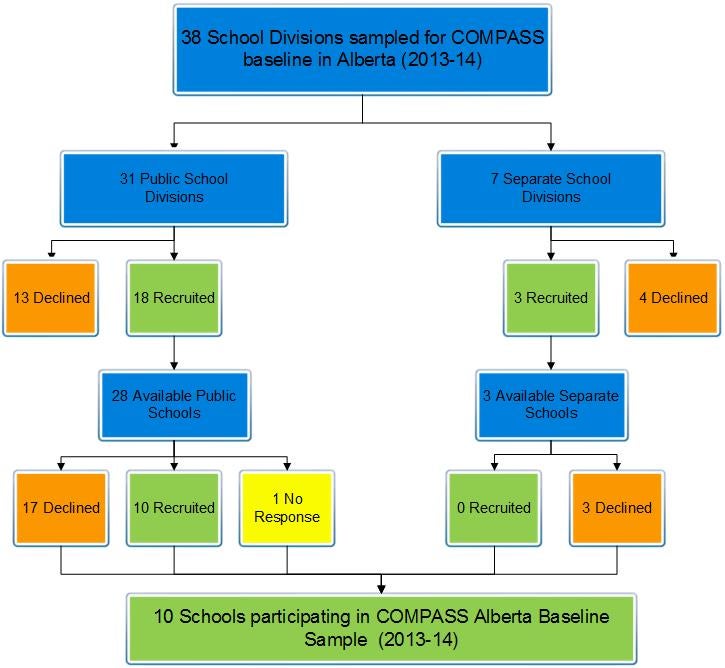Compass Technical Report Series, Volume 3, Issue 1 April 2015 (PDF)
COMPASS technical report series, volume 3, issue 1, April 2015
Table of contents
Acknowledgements
Introduction
Determining the eligible school division sampling results (baseline 2013-14)
School division and school recruitment
School division recruitment
School recruitment
Discussion
References
Acknowledgements
Authors
Morgan Wagner, BScKin (Faculty of Physical Education and Recreation, University of Alberta, Edmonton, AB)
Chad Bredin, BA (Propel Centre for Population Health Impact, University of Waterloo, Waterloo, ON)
Audra Thompson-Haile, MA (Propel Centre for Population Health Impact, University of Waterloo, Waterloo, ON)
Scott Leatherdale, PhD (School of Public Health and Health Systems, University of Waterloo, Waterloo, ON)
Report funded by
The COMPASS study was supported by a bridge grant from the Canadian Institutes of Health Research (CIHR) Institute of Nutrition, Metabolism and Diabetes (INMD) through the “Obesity – Interventions to Prevent or Treat” priority funding awards (OOP-110788; grant awarded to S. Leatherdale) and an operating grant from the Canadian Institutes of Health Research (CIHR) Institute of Population and Public Health (IPPH) (MOP-114875; grant awarded to S. Leatherdale).
Suggested citation
Wagner M, Bredin C, Thompson-Haile, A & Leatherdale ST. Alberta Baseline Sampling and Recruitment Results. COMPASS Technical Report Series. 2015; 3(1).Waterloo, Ontario: University of Waterloo. Available at: www.compass.uwaterloo.ca.
Contact
COMPASS research team University of Waterloo 200 University Ave West, BMH 1038 Waterloo, ON Canada N2L 3G1 compass@uwaterloo.ca.
Introduction
COMPASS is a longitudinal study (that started in 2012-13) designed to follow a cohort of grade 9 to 12 students attending a convenience sample of Ontario secondary schools for four years to understand how changes in school environment characteristics (policies, programs, built environment) are associated with changes in youth health behaviours [1]. The Ontario sample was expanded in 2013-14 along with the addition of a sample of Alberta schools; this cohort will be tracked for three years. COMPASS originated to provide school stakeholders with the evidence to guide and evaluate school-based interventions related to obesity, healthy eating, tobacco use, alcohol and marijuana use, physical activity, sedentary behaviour, school connectedness, bullying, and academic achievement. COMPASS has been designed to facilitate multiple large-scale school-based data collections and uses in-class whole-school sampling data collection methods consistent with previous research [2-5]. COMPASS also facilitates knowledge transfer and exchange by annually providing each participating school with a school-specific feedback report that highlights the school-specific prevalence for each outcome, comparisons to provincial and national norms or guidelines, and provides evidence-based suggestions for school-based interventions (programs and/or policies) designed to address the outcomes covered in the feedback report (refer to: www.compass.uwaterloo.ca).
This technical report provides details on the school division and school recruitment results for the Alberta baseline sample of COMPASS (2013-2014).
Determining the eligible school divisions for the baseline sample
As the COMPASS study does not require a provincially-representative sample of schools, Alberta school divisions were purposefully selected for this study. As described previously with the Ontario baseline sample [5], the inclusion criteria for Alberta Divisions included all English speaking school divisions that had secondary schools with grades 9 through 12 and a student population of a least 90 students or greater per grade level; had schools that operated in a standard school/classroom setting; and, permitted the use of active-information passive-consent parental permission protocols. Since a large portion of Alberta secondary schools include grades 10 to 12, these schools were also included in the sample.
As shown in figure 1, of the 63 School Divisions in Alberta [6]: a) four French speaking divisions were removed from the sample due to budgetary considerations associated with having to translate all of the COMPASS materials from English to French; b) one school division was removed from the sample because it was comprised of schools that do not take place in a traditional or standard school/classroom setting (i.e., in hospitals, special education centres, or online); c) 11 school divisions were removed from the sample because the student population within each secondary school in the division was too small to allow for robust analytical models; d) nine schools divisions were removed from the sample due to mandatory active consent procedures which would not allow us to have representative student data at the school level that are required for the COMPASS knowledge transfer activities and for answering the program and policy related research questions in COMPASS. This resulted in a COMPASS Alberta school division baseline sample of 38 eligible school divisions.

Figure 1: COMPASS Alberta school division sampling results (Baseline 2013-2014)
School division and school recruitment
The 38 schools divisions eligible for COMPASS were contacted between September 2013 and February 2014 to ensure that approved schools from consenting divisions could be approached with enough time remaining in the school year to complete a data collection. Parallel to school board recruitment methods used in Ontario [5] each eligible division was either sent a COMPASS recruitment package or a division specific research application package. Eligible schools were approached to participate in COMPASS only after their division granted the COMPASS team approval. The school division and school recruitment results for the COMPASS Alberta baseline sample are presented in figure 2.
School division recruitment
Of the 38 eligible school divisions, there were 31 Public school divisions and seven separate school divisions approached to participate in COMPASS. Among the 31 Public school divisions approached, 18 (58%) divisions agreed to participate and 13 (42%) divisions declined to participate. Among the seven Separate school divisions approached, three (43%) divisions agreed to participate and four (57%) divisions declined to participate. This resulted in a final sample of 21 school divisions in Alberta who approved the COMPASS study.
During the school division recruitment procedures, COMPASS staff provided school divisions who declined to participate with the opportunity to provide one or more reasons for their refusal decision if they felt so inclined. This was done so that the team could identify if there were any methodological concerns associated with the study that could be improved. Among the divisions that provided one or more reasons for their refusal, the most common response was that the divisions were already taking part in other research projects on similar topics and that the division was “too busy”.

Figure 2: COMPASS Alberta school divisions and school recruitment results (Baseline 2013-2014)
School recruitment
Based on the inclusion criteria for COMPASS [7], there were 28 eligible Public schools within the 18 recruited Public school divisions and three eligible Separate schools within the three Separate school divisions. Among the 28 Public schools approached, 10 (36%) schools agreed to participate, 17 (61%) declined to participate, and one school did not provide a response. All 3 separate schools declined participation. While private schools that follow a traditional educational setting were considered to be a part of the sample, none had student populations large enough to meet the inclusion criteria. Of the 10 recruited schools, six were grades 9 to 12 and four were grades 10-12.
Similar to the division recruitment procedures, during school recruitment we provided schools that declined to participate with the opportunity to provide one or more reasons for their refusal decision if four they felt so inclined. Among the schools that provided one or more reasons for their refusal, the most common response was that schools were already involved in competing research, fearful that their students would become over-researched and that the schools were “too busy”.
Discussion
COMPASS division and school protocols were developed based on the COMPASS team’s previous experience conducting research in school settings. Since 2000, members of the team have used these methods in all provinces across Canada recruiting more than 2000 schools for various projects. While these methods have proven effective in both division and school recruitment historically, COMPASS researchers predicted that the recruitment rate in Alberta would be lower than the Ontario rates and were aiming for a minimum of 10 participating school.
One major factor limiting COMPASS participation rates in school divisions and schools across Alberta is the amount of competing research in the school system. For example, many of the schools approached to participate are already committed to a three-year school achievement study called Tell Them From Me or are completing their own internal surveys related to student health and wellbeing. The second major factor limiting the participation rates for Alberta was the limited number of divisions and schools that met all of the eligibility criteria. Most schools' divisions only had one or two schools that fit the requirements of the COMPASS study. With these limitations to participation and recruitment, COMPASS was able to successfully recruit the minimum 10 schools for Alberta baseline data collection.
References
1. Leatherdale, S.T., Brown, K.S., Carson, V., Childs, R.A., Dubin, J.A., Elliott, S.J., Faulkner, G., Hammond, D., Manske, S., Sabiston, C.M., Laxer, R.E., Bredin, C. & Thompson-Haile, A. The COMPASS study: a longitudinal hierarchical research platform for evaluating natural experiments related to changes in school-level programs, policies and built environment resources. BMC Public Health 2014, 14:331.
2. Leatherdale ST, Burkhalter R: The substance use profile of Canadian youth: exploring the prevalence of alcohol, drug and tobacco use by gender and grade. Addict Behav 2012, 37:318-322.
3. Leatherdale ST, Manske S, Faulkner G, Arbour K, Bredin C: A multi-level examination of school programs, policies and resources associated with physical activity among elementary school youth in the PLAY-ON study. Int J Behav Nutr Phys Act 2010, 25;6. doi: 10.1186/1479-5868-7-6.
4. Leatherdale ST, McDonald PW, Cameron R, Brown KS: A multi-level analysis examining the relationship between social influences for smoking and smoking onset. Am J Health Behav 2005, 29:520-530.
5. Leatherdale ST, Papadakis S: A multi-level examination of the association between older social models in the school environment and overweight and obesity among younger students. J Youth Adolesc 2011, 40:361-372.
6. Thompson-Haile A, Leatherdale ST. School Board and School Recruitment Procedures. COMPASS Technical Report Series. 2013;1(3). Waterloo, Ontario: University of Waterloo. Available at: http://www.compass.uwaterloo.ca/.
7. Alberta Education (2014). Authorities and School Directory. Available at: https://education.alberta.ca/apps/schoolsdir/.